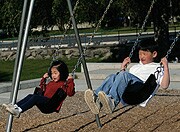
MONDAY, April 2 (HealthDay News) — Roughly half of America’s preschool-aged children are not getting a daily dose of parentally supervised outdoor playtime, a new study reveals.
Analyzing data on nearly 9,000 children previously collected in a long-term U.S. study, researchers found that much of the country’s youth, especially young girls, aren’t engaging in routine outdoor physical activities.
“One of the main points is that even though many of us may assume that young children spend some time outdoors every day, there’s considerable room for improvement in how often parents take their children outside to play,” said study lead author Dr. Pooja Tandon, a pediatrician and researcher with the Seattle Children’s Research Institute.
“This study highlights something we already know from other studies, which is that girls in particular seem to have fewer opportunities for outdoor play than boys. We have to try to support girls in the same way we encourage boys to be active and to play outdoors,” added Tandon, who is also an acting assistant professor in the department of pediatrics at the University of Washington in Seattle.
The findings appear online April 2 in the Archives of Pediatrics & Adolescent Medicine.
The study authors said the American Academy of Pediatrics suggests doctors take a proactive role in encouraging routine physical activity among kids, particularly outdoor activity, which can be critical to helping children develop motor skills, as well as promoting vision and mental acuity.
The research team looked at statistics on the outdoor-activity routines of 8,950 children born in 2001 who were tracked through enrollment in kindergarten. The data were deemed to be nationally representative, reflecting the behavior of an estimated 4 million kids.
Each child’s mother was interviewed regarding the frequency and nature of her child’s outdoor play experience at the ages of 9 months, 2 years and 4 years, (or a year before kindergarten) and then again once enrolled in kindergarten.
Only 51 percent of the kids were found to be following a daily routine of parent-supervised outdoor play. That figure, however, rose slightly — to 58 percent — among children who were not enrolled in some form of child care.
Boys were more likely than girls to get daily outdoor exercise, and children whose parents were more likely to exercise also were more likely to get out on a daily basis.
What’s more, race seemed to play a role, with children from white families getting substantially more outdoor play than those with Asian, black or Hispanic mothers. Specifically, Asian mothers were 49 percent less likely to take their children outdoors for play, black mothers were 41 percent less likely and Hispanic mothers were 20 percent less likely.
Mothers were more likely than fathers to be the supervising parent during outdoor play — 44 percent of mothers said they took their child out for daily play, while only 24 percent of fathers did so.
TV-watching habits of children did not affect the findings. Nor did mothers’ marital status, perceived neighborhood safety or family income levels.
“I want to encourage parents to talk to all their child’s caregivers, and to ask about their outdoor playtime experience in the same way they would normally ask about how much their child ate that day and what they learned,” Tandon said.
Rahil Briggs, a child psychologist with Children’s Hospital at Montefiore, in New York City, agreed that “there’s a very real need for growing children to have outdoor play.”
“Unfortunately, I’m not too surprised with these findings, because of what we already know about the obesity epidemic in this country and all the sedentary activities our children are partaking in with the use of video games, TV, the iPad and all of that,” she said.
“Parents need to change their thinking about outdoor play as a luxury that they can get in for their kids on a Saturday, to something along the lines of a necessity,” Briggs said. “We need to know that it has an important impact on our children’s physical health and also on their behavioral development and concerns.”
More information
For more on children and exercise, visit the U.S. Centers for Disease Control and Prevention.

